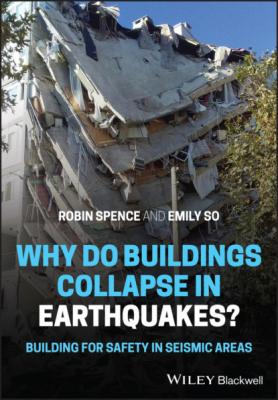Why do buildings collapse in earthquakes? Building for safety in seismic areas. Robin Spence
Чтение книги онлайн.
Читать онлайн книгу Why do buildings collapse in earthquakes? Building for safety in seismic areas - Robin Spence страница 2
 href="#ulink_26002cf4-14f9-5440-bd8c-6ae65a2905b6">9.5 Scientists and Engineers
9.6 NGOs
9.7 Insurers
9.8 The Way Forward
References
href="#ulink_26002cf4-14f9-5440-bd8c-6ae65a2905b6">9.5 Scientists and Engineers
9.6 NGOs
9.7 Insurers
9.8 The Way Forward
References
14 Index
List of Tables
1 Chapter 2Table 2.1 Significant earthquakes worldwide since 2000, ordered by number of ...Table 2.2 Distribution by World Bank Income Groups of deaths and damage costs...
2 Chapter 3Table 3.1 The five primary classes of climatic zones in the Köppen–Geiger cla...
3 Chapter 5Table 5.1 Principal classes of buildings and brief descriptions.Table 5.2 Brief definitions of damage states for masonry and reinforced concr...Table 5.3 Proportion of buildings of each vulnerability class expected to suf...
4 Chapter 6Table 6.1 Table showing what happened to the occupants inside the two collaps...Table 6.2 An excerpt of slope failure consequence data triggered by the Mw7.9...Table 6.3 Sample of judgement‐based fatality rates for 15 different building ...
5 Chapter 7Table 7.1 Performance objectives set out in the new revision of Eurocode 8.Table 7.2 School collapses in earthquakes yielding multiple casualties 2001–2...
6 Chapter 9Table 9.1 Most costly events since 2000, and proportion of insurance cover.
List of Illustrations
1 Chapter 2Figure 2.1 Stone masonry building in the Kutch district damaged in the Bhuj ...Figure 2.2 Brick masonry building with reinforced concrete floors damaged in...Figure 2.3 Reinforced concrete building in the Kutch district and typical da...Figure 2.4 Damage to a reinforced concrete building in Bhuj, and view of the...Figure 2.5 High‐resolution satellite imagery of the centre of Bam taken (lef...Figure 2.6 Failure of adobe dwelling in the Bam earthquake.Figure 2.7 Damage caused by the 26 December 2004 tsunami at Unawatuna, Sri L...Figure 2.8 Damage caused by the 26 December 2004 tsunami at Unawatuna, Sri L...Figure 2.9 2005 Kashmir earthquake: damage in the Muzaffarabad district. Aer...Figure 2.10 2005 Kashmir earthquake: damage in the Muzaffarabad district. Da...Figure 2.11 Collapse of house of traditional construction, Yogyakarta earthq...Figure 2.12 Partially collapsed five‐storey masonry middle school building i...Figure 2.13 Typical damage to low‐rise informal building in Port au‐Prince....Figure 2.14 Typical damage to pre‐1930s masonry buildings in Christchurch.Figure 2.15 Typical damage in tsunami‐affected region. Timber frame building...Figure 2.16 Typical damage in tsunami‐affected region. Steel frame building ...Figure 2.17 Typical damage to masonry construction in urban areas of Nepal....Figure 2.18 Typical damage to masonry construction in urban areas of Nepal....Figure 2.19 Earthquake damage and fatalities by country 2000–2019, using a l...Figure 2.20 Global earthquake mortality rate since 1900 (deaths per 100 000 ...
2 Chapter 3Figure 3.1 Köppen–Geiger climate classification: boundaries of the major cli...Figure 3.2 Timber‐framed house with lightweight walls and roof in warm humid...Figure 3.3 Village housing in the hot‐dry area of Iran. Open courtyards, clo...Figure 3.4 Estimated seismic resistance index for buildings designed with ap...Figure 3.5 The GEM global seismic hazard map with the 10 zones identified in...Figure 3.6 Distribution of urban residential building types by 10 seismic re...Figure 3.7 Reinforced concrete dual frame and shear‐wall apartment building ...Figure 3.8 Stone masonry urban houses in Italy.Figure 3.9 Rural adobe house in Iran.Figure 3.10 Reinforced concrete frame apartment building in Turkey.Figure 3.11 Dhajji Dewari building in Srinagar, Kashmir.Figure 3.12 Qionglong building in Sichuan Province.Figure 3.13 Damaged reinforced concrete frame building in Dujianyang after 2...Figure 3.14 Ordinary urban wooden housing in Japan 1970s and 1980s.Figure 3.15 Typical form of traditional shinkabe timber frame house used in ...Figure 3.16 Confined masonry house in Bengkulu, Indonesia, 2007.Figure 3.17 Traditional masonry house in Yogjakarta, Indonesia, 2006.Figure 3.18 Typical New Zealand wood‐frame house.Figure 3.19 Soft‐storey damage to older wood‐frame house in 2011 Christchurc...Figure 3.20 Confined masonry apartment buildings in Chile.Figure 3.21 Concrete shear wall apartment building in Chile.Figure 3.22 Distribution of housing by construction type in Zone 8 countries...Figure 3.23 Reinforced concrete frame construction in Mexico.Figure 3.24 Confined masonry housing in Guatemala 2019.Figure 3.25 Bahareque reconstruction after the 1986 earthquake in El Salvado...Figure 3.26 Typical wood‐frame single‐family housing in California.Figure 3.27 Wall framing system used in wood‐frame housing construction in C...
3 Chapter 4Figure 4.1 Diagrams showing different types of earthquakes.Figure 4.2 Þingvellir National Park in Iceland, where the Eurasian and North...Figure 4.3 The San Andreas fault in California, USA.Figure 4.4 An irrigation tunnel (qanat) has been dug through alluvium toward...Figure 4.5 Diagrams showing (TOP) relative peak bedrock ground accelerations...Figure 4.6 Figure showing the natural periods of structures of different hei...Figure 4.7 This diagram shows the most damaged types of buildings in the 198...Figure 4.8 Clean‐up operations of damage caused by liquefaction in Christchu...Figure